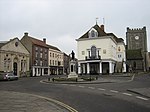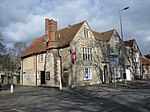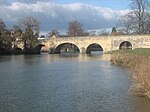Municipal Borough of Wallingford
The Municipal Borough of Wallingford was an administrative district based on the town of Wallingford, historically in Berkshire, now in administrative Oxfordshire, in southern England. Established in 1834 and disbanded in 1974, when it became part of South Oxfordshire. The municipal borough, administered by Wallingford Borough Council, was based on the ancient borough of Wallingford, which itself was centred on Wallingford’s burh. Wallingford was established as a borough by the time of the Domesday book. Municipal records begin with burghmote rolls in 1232 and gild records in 1227, and the first mayor is recorded for 1231. The borough was given parliamentary representation as a parliamentary borough in 1295, which continued until 1885. The Mayor of Wallingford remains a title associated with Wallingford Town Council.
Excerpt from the Wikipedia article Municipal Borough of Wallingford (License: CC BY-SA 3.0, Authors).Municipal Borough of Wallingford
St Mary's Street, South Oxfordshire Winterbrook
Geographical coordinates (GPS) Address Nearby Places Show on map
Geographical coordinates (GPS)
| Latitude | Longitude |
|---|---|
| N 51.599 ° | E -1.125 ° |
Address
Indigo rye
St Mary's Street
OX10 0LE South Oxfordshire, Winterbrook
England, United Kingdom
Open on Google Maps









